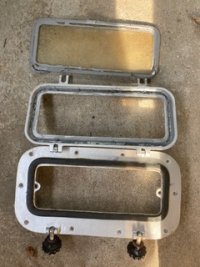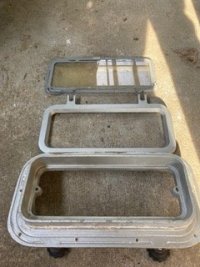PANorth
Member II
We have gotten to the point of digging the fogged plastic lenses out of the aluminum frames. We removed the frames because they held the laminate to the cabin side. The flange goes through the cabin side from the inside out, with an aluminum piece that matches all around the flange on the outside of the cabin. Bolts through the cabin side hold the outside piece to the inside portlight (you can see the bolt holes).
A few questions come up? What is a good method for removing the old adhesive from the frames. There is adhesive where the lenses are glued to the frame (grey) and for the frame to the cabin side (white). It's not the same adhesive. Are there recommended replacement adhesives?
Is there any reason that I should not replace the plastic lenses with glass? It would be nice to see through them forevermore. Would tempered glass be the thing?
Finally, the coating on the frames has bubbled in places with minor corrosion. Does anyone have experience with sandblasting and recoating aluminum portlight frames? Any ideas about the proper coating? Or is it even necessary?
I've read through the posts but did not see these questions addressed.
A few questions come up? What is a good method for removing the old adhesive from the frames. There is adhesive where the lenses are glued to the frame (grey) and for the frame to the cabin side (white). It's not the same adhesive. Are there recommended replacement adhesives?
Is there any reason that I should not replace the plastic lenses with glass? It would be nice to see through them forevermore. Would tempered glass be the thing?
Finally, the coating on the frames has bubbled in places with minor corrosion. Does anyone have experience with sandblasting and recoating aluminum portlight frames? Any ideas about the proper coating? Or is it even necessary?
I've read through the posts but did not see these questions addressed.




